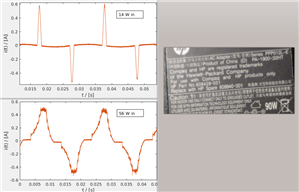Denis McMahon:.
Higher harmonics can also add, but they are less of an issue because they are much smaller.
I gave this more thought as I was clipping my yew hedge this afternoon.
A flute produces something near a sine wave, but a clarinet does not. However, if the magnitude of any harmonic were greater than the fundamental, would that frequency not be the fundamental?
I then wondered what would happen if all the current were at the third harmonic. It seems fairly clear that now we simply have a supply at 150 Hz.
So now I wonder whether the triplen harmonic(s) can ever be more than 50% of the current.
Let's have a balanced load of 100 A per phase and 50% 3rd harmonic. 3 x 50 A at 50 Hz cancel out; and 3 x 50 A add up so we have 150 A in the neutral.
Now let's take a supply with 100 A on 2 phases and none on the third. The third harmonic accounts for 50 % of the current. So at 50 Hz, 50 A goes down the neutral.* At 150 Hz 2 x 50 A goes down the neutral. So now we have 100 A in two of the line conductors and 150 A in the neutral.
Doubtless the likes of Mike or OMS will comment if I am talking drivel. ?
* see Annex A722.
So now we have 100 A in two of the line conductors and 150 A in the neutral.


Chris Pearson:Denis McMahon:.
Higher harmonics can also add, but they are less of an issue because they are much smaller.I gave this more thought as I was clipping my yew hedge this afternoon.
A flute produces something near a sine wave, but a clarinet does not. However, if the magnitude of any harmonic were greater than the fundamental, would that frequency not be the fundamental?
I then wondered what would happen if all the current were at the third harmonic. It seems fairly clear that now we simply have a supply at 150 Hz.
. . .
Isn't gardening therapeutic! Many of my inspirations come when I am in the shower.
Anyway, taking the points on sound waves. The sound of a clarinet is stronger in harmonics than that of a flute, so its waveform is less like a sound wave. The oboe gives even richer harmonics, thus more of a piercing sound. Now take a quite different instrument, the violin, where the harmonics are so strong and ordered that it is almost saw-tooth in shape.
If a harmonic had greater magnitude than a fundamental, would it not be the fundamental? My answer would be "no". The fundamental is by definition the lowest frequency. It usually has the largest amplitude but this does not need to be so. A telephone line cannot handle frequencies less than 300 Hz so low harmonics are suppressed. This makes a voice over the phone sound "thin". The fundamental of the human voice is less than 300 Hz; male speech fluctuates around 100 Hz. But the fundamental effectively "modulates" the higher harmonics. These modulations are heard over the telephone, and the brain can interpret them to derive the fundamental. So if, for example, someone sings over the phone, we can follow the fundamental pitch.
What if all the current were at the third harmonic? The harmonics are produced as a result of the response of the circuitry to the fundamental frequency of the supply p.d. The only way I could see all three phases at 150 Hz would be if that were the supply frequency. In which case, they would be fundamental frequencies, cancelling one another if equal, and the third harmonics would be 450 Hz.
Sparkingchip:
I have found a Diagram that shows the waves in relation to each other showing why you can end up 200% above where you expect to be.
Andy B.
Very useful diagram - explains the addition of third harmonics very well. Thanks for finding it, Andy.
It does not, however, explain mathematically to my understanding why you can reach 200% in the neutral. However L & T has obviously done some research into this so I'll take its word for it.
We're about to take you to the IET registration website. Don't worry though, you'll be sent straight back to the community after completing the registration.
Continue to the IET registration site